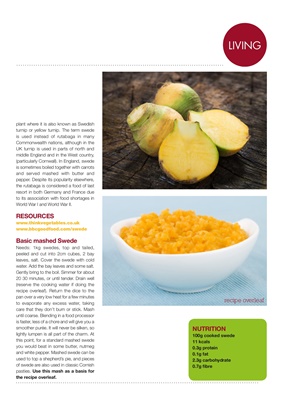
KITLIVING
recipe overleaf
plant where it is also known as Swedish
turnip or yellow turnip. The term swede
is used instead of rutabaga in many
Commonwealth nations, although in the
UK turnip is used in parts of north and
middle England and in the West country,
(particularly Cornwall). In England, swede
is sometimes boiled together with carrots
and served mashed with butter and
pepper. Despite its popularity elsewhere,
the rutabaga is considered a food of last
resort in both Germany and France due
to its association with food shortages in
World War I and World War II.
RESURCES
www.thinkvegetables.co.uk
www.bbcgoodfood.com/swede
Basic mashed Swede
Needs: 1kg swedes, top and tailed,
peeled and cut into 2cm cubes, 2 bay
leaves, salt. Cover the swede with cold
water. Add the bay leaves and some salt.
Gently bring to the boil. Simmer for about
20 30 minutes, or until tender. Drain well
(reserve the cooking water if doing the
recipe overleaf). Return the dice to the
pan over a very low heat for a few minutes
to evaporate any excess water, taking
care that they don't burn or stick. Mash
until coarse. Blending in a food processor
is faster, less of a chore and will give you a
smoother purée. It will never be silken, so
lightly lumpen is all part of the charm. At
this point, for a standard mashed swede
you would beat in some butter, nutmeg
and white pepper. Mashed swede can be
used to top a shepherd's pie, and pieces
of swede are also used in classic Cornish
pasties. Use this mash as a basis for
the recipe overleaf.
NUTRITION
100g cooked swede typically
contains
11 kcals
0.3g protein
0.1g fat
2.3g carbohydrate
0.7g fibre